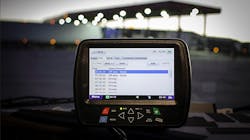The Impact Of The ELD Mandate On A Total Mobility Solution
With the electronic logging devices (ELD) mandate looming, and regardless of a potential delay due to continuing legislative review, it’s important for fleets to understand the impact it has on their business and strategically plan how to implement the new standards.
While the ELD mandate can be perceived as overwhelming and confusing, this regulation should be looked at as an opportunity to not only meet, but also exceed, its expectations. Fleets should be thinking broader in order to set up their in-vehicle strategy for success, and consider their Total Mobility Solution. The right strategy is critical to not only save time and money now, but to maximize the company’s return on investment long term.
A Total Mobility Solution ensures a safe, comfortable and efficient mobile office for any fleet, and it has five key components. There are numerous options available within each component, and each should be evaluated for its function and reliability in the field, as well as overall value.
1. Software
Software solves business problems, like the ELD Mandate. Software will allow fleets to oversee GPS tracking, route planning/mapping, dispatch, driver management and more.
2. Hardware
Appropriate hardware is essential to a mobility solution as it is the key to operating software. Fleets should consider the environment within which the hardware will operate – whether ultra-rugged, non-rugged or somewhere in between – in order to develop a solution to fit its needs.
As for the actual electronic ELD, it is important to note it is not the same as an automatic onboard recording device (AOBRD). The technical specifications are different. Manufacturers will be able to notify owners of existing AOBRDs if their devices are capable of being updated to meet ELD requirements through software updates.
3. Connectivity and Integration
Successful mobility solutions are supported by reliable connections to mobile networks, including back-end systems. Identify connectivity needs in terms of Internet access, SIM (Subscriber Identity Module) services or Cloud storage. Fleets should carefully consider the options they have before making a final decision.
4. Docking and Mounting
When considering a successful mobile solution, the safety of those in the vehicle is paramount to all other considerations. If not properly secured, hardware and equipment can become hazardous projectiles in the event of a sudden stop or collision. Quality docking solutions keep hardware in place, ensuring both safety and functionality by minimizing the risk of a device disconnecting in rugged conditions.
Fleets should consider a driver’s or passenger’s ability to see, operate and maneuver a device and its connected peripherals, including printers, keyboards, scanners and antennas. Successful mounting solutions organize in-vehicle equipment and conserve space for maximum usability, comfort and productivity.
Another top concern when considering in-vehicle displays and safety is minimizing driver distraction. Distracted driving costs thousands of lives every year and has an average economic impact of $123 billion each year in property damage, medical bills and workplace injuries, according to the National Highway Traffic Safety Administration.
Consider solutions designed to work with devices and software to minimize physical and visual distractions. One example is screen-blanking technology, which is an easy-to-install solution that limits the functionality of a device while a vehicle is in motion.
Many OEMs work directly with docking and mounting solution providers to design equipment that is compatible with specific brands and models of vehicles or computing devices. For fleets purchasing equipment, it means that docking and mounting solutions may be available for a specific vehicle or computing device.
5. Professional Installation
To guarantee the effectiveness of a mobile solution, fleets should seek proper installation by professionals familiar with the docking, mounting and connectivity of the system. Manufacturer sales representatives can also be used as a resource to help ensure maximum product compatibility, develop a customized solution, identify bundling opportunities and connect fleets with warranties to add additional value to a purchase.
To avoid the hassle and potential hazards of configuring multiple docking and mounting products into one solution, consider solutions that bundle compatible products. Bundled solutions ensure that all parts are fully integrated to operate properly as designed.
Support
Beyond product quality and features, consider the support a fleet may need in choosing, installing and operating devices, software and docking and mounting equipment. Recommendations from other professionals in the field are also useful when making a decision regarding a product or installation vendor. The right vendor will have the expertise to guide fleets towards a mobile office solution that accommodates their needs, meets standards and fits within a set budget.
One possible reason why E-Logs have not had a measurable impact on capacity may be that fleets also use other technologies alongside their ELD applications. Fleets are leveraging their investments in E-Logs with companion applications that help maximize fuel efficiency and safety.
There are many ELD providers that offer platforms with performance applications – including video event recorders and route planning tools – that help fleets generate additional returns on investment.
Implementing a plan to incorporate ELD can appear overwhelming, but fleets can make the process easier and more productive by considering a Total Mobility Solution to set up their in-vehicle strategy for success.
Keith Steidle is director of business development and marketing for Havis Inc. (www.havis.com), a designer and manufacturer of computer docking and equipment mounting solutions for mobile applications.
